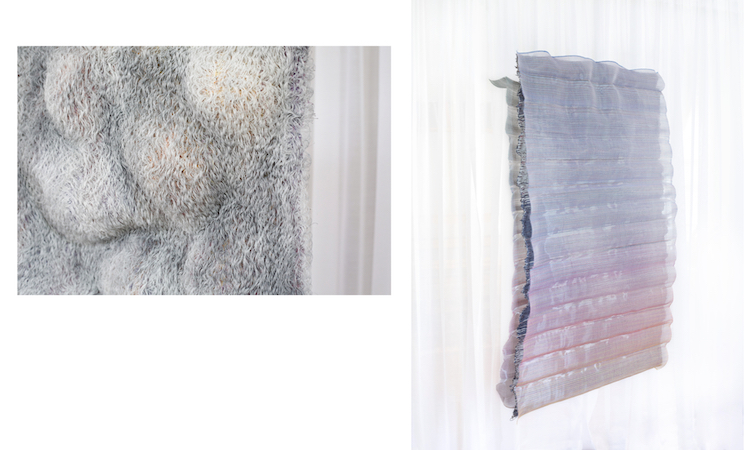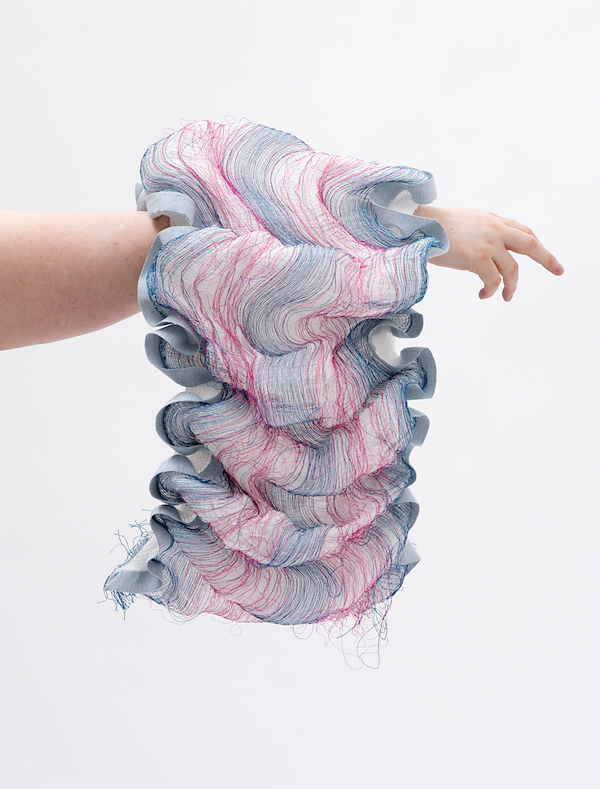It’s the time of year again when CU Boulder opens its application process and considers new PhD students. It’s unclear if we will admit a new PhD student to the lab this year, but if the fit is right and you have an amazing vision we can support, it’s possible. Some of the current projects in the lab include:
- Open Source Hardware Development for Improvisational Interactions with the TC2 (led by ATLAS PhD Shanel Wu with and OSHWA Trailblazer Fellowship)
- Outreach around the resonance of computer programming and weaving with Denver Public Libraries in collaboration with ATLAS PhD Deanna Gelosi and the Creative Communities Group.
- Developing and exploring bio-synthetic fibers with ATLAS PhD Eldy Lazaro, the Living Matter Lab and Utility Research Lab.
- Ongoing Development and Exhibition of the Research Lab of Ambiguous Futurology, Led by IAWP PhD Student Sasha De Koninck
- Ongoing development of AdaCAD to support complex weaving practices, open-source software and community building, and further integrations of programming and weave structure generation.
The lab is associated with several PhD programs at CU Boulder and applicants to this position must submit their application through one of the programs listed below:
We hope to find candidates that are eager to grow and contribute as a member of both the lab, as well as their selected academic unit. As a lab, we value critical thinking and making that question relationships between design and society, tools and equity in computing, and placing equal value in art, craft, and engineering.
If you are interested in this opportunity, we encourage you to reach out to us via email, as that will help us get familiar with your name and look for it in the applications list. Interested applicants should contact the lab via email (unstabledesignlab@gmail.com) with any links or information that would help us to get to know you better. Please include a short note about which program you might want to apply through and what, in particular, you find interesting about this opportunity. This email is NOT your application, just a way for us to get to know you better so we can look out for your application if/when it comes in.
FAQ
Why do people get PhD’s, what good are they?
Great question! – PhD’s are one of many career paths and are better/worse suited to get you where you want to go, depending on your ambitions. PhD programs also vary from program to program, so what I write here is not universal to all PhDs programs — but specific to the programs we work within. PhD’s though this program emphasize preparation for careers in research (as well as teaching, but typically with a higher emphasis on research than teaching preparation). They are set up to prepare students to pursue a set of questions or ideas that capture their imagination and are guided to produce work that contributes knowledge to a given community. The program is designed to be completed in four years, but most people tend to complete their PhD in 4-6 years. That community, and kind of work, depend on the program that you apply through (see below). People who get PhD’s often times pursue an academic career and a higher-ed institution, or research-based company.
What does it mean to apply into a lab vs. a program?
In our university structure, the “lab” you work in is often related to the person who serves as your primary advisor (in this case, that would be Laura Devendorf). Yet, some students who work in my lab are not primarily advised by me, and people I advise can choose to participate in other labs. When you apply to a PhD program, it is often recommended to specify who, of the research faculty, you would want to advise you and you may want to list a few names if you see resonance between your interests and what faculty do. In our programs, that advisor (with guidance from broader groups) is responsible for cultivating your research practice, making sure you progressing adequately, and, most importantly, with paying for your tuition, stipend, and fees. When selecting an advisor, its useful to consider both professional and interpersonal dynamics–is this a person who you want to learn from and that shares or aligns with your values as a human. When an advisor is looking for a student, they are usually trying to match students to projects where they need support (and have money to pay), as well as how their interests and potentials complement the direction and other members of the lab.
What is the difference between the four programs?
The Unstable Design Lab, the physical space and resources, are housed within the ATLAS Institute, which is an academic program focused on interdisciplinary collaboration. Thus, every professor working in the ATLAS Institute has affiliations with other campus departments and has the ability to serve as the primary advisor to PhD students. As a tip, when writing you application, be sure to focus on arguing your interest in the program you are applying to first, and your interest in the lab as a secondary comment. This is because you will be part of the program as much as you will be part of the lab.
ATLAS Institute
The ATLAS program, which is part of the College of Engineering and Applied Science, is designed for students whose expertise does not fall into a traditional discipline. The program emphasizes “creative technology and design” and most of the students in the program follow an engineering-style PhD, creating research prototypes and products and publishing them in academic research venues. Students in this program develop their own curriculum from across the campus offerings.
Please review the ATLAS Institute website for a broader understanding of the program and requirements and to get a sense of the work underway by students and faculty.
Information Science
The Dept. of Information Science, which is part of the College of Communication, Media, and Information, is designed for students interested in the intersection of technology and society. The program is more structured than ATLAS and introduces all students to a common set of methods for qualitative and quantitative analysis, and over time, invites them to develop and publish original research products.
Please review the website Department of Information Science for a broader understanding of the program and requirements and to get a sense of the work underway by students and faculty.
Computer Science
The Dept. of Computer Science, which is part of the College of Engineering and Applied Sciences, is designed for students interested in publishing contributions towards fields associated with computer science
Please review the website Department of Computer Science for a broader understanding of the program and requirements and to get a sense of the work underway by students and faculty.
Intermedia Art, Writing and Performance
The Dept. of Intermedia Art, Writing and Performance, which is part of the College of Communication, Media, and Information, and is a practice-led PhD program that prioritizes the production and dissemination of creative work.
Please review the website Intermedia Arts Writing and Performance Program for a broader understanding of the program and requirements and to get a sense of the work underway by students and faculty.
How will my application be reviewed?
The primary question that I think application processes focus upon is (1) whether the program you apply towards can adequately help you meet your goals and (2) whether your goals align with the particular interests and funding options for a given faculty member.
The process beings with an interested student submitting an application to the program that most suits them, and listing their interest in working with a lab or particular advisor within their statement of intent. When reviewing the applications, each program will make collective decisions on the fit of the student to their program. Adding the name of a potential advisor to your statement of intent often means that the person you name will have a say in determining if you are accepted. Emailing us ahead of time to let us know who you are and what you are interested in allows us to recognize your name as the applications come in.
How do PhD Students Make a Living?
Students in a PhD program are given funding letters that explicitly outline the stipend (pay) they will receive on a monthly basis. This typically covers only 9 months our of a year, but there are opportunities for summer funds based on programs and in the form of paid research internships. Sometimes this funding is tied to work as a Teaching Assistant (e.g. running class sections and grading work) or as a Research Assistant (e.g. performing work on a funded project). The stipend varies by program and is not luxurious, especially by Boulder standards, but can provide relief on monthly expenses. Some students supplement income with grants, side projects and or more lucrative summer research internships. For the most honest perspectives on funding, I would encourage students to reach out to existing PhD students in their program of interest. This topic is also covered in detail at orientation events for accepted students.
Do I have to enroll in one of the programs to be part of the lab?
Currently, yes, though we will continue to host our experimental weaving residency for those interested in temporary visits and/or affiliations.



